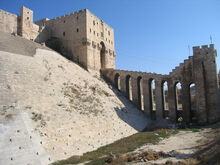| Karadra | |
|---|---|
 | |
|
Lord: |
|
|
Dominion: |
4,200 square miles |
|
Capital: |
Karaandra |
Karadra is a southerly house, located on the border of the great desert. It is constantly changing hands as the men of the desert vie for control.
History[]
600 years ago, the men of Emiria marched into the desert, seeking to expand their kingdom and explore new lands. They found only miles and miles of sand, ruins, and dust. Hundreds died from dehydration, and they were eventually forced to turn back.
It was here that they were ambushed by the desert people, nomads who travelled through the sands, living from the oases and at constant war with each other. They were numerous, the tribes locked in eternal conflict. Only a few escaped the bows and spears of the desert men, and they were quick to bring back a retaliatory force.
This new army found nothing of the attackers. They built a series of fortresses along the border, just in case the desert people might attack Emiria from below.
These fortresses saw no activity for many decades, and so the soldiers went back home. They began to decay, empty of people and not receiving any maintenance.
The desert people found the largest one and began to mould it after their own style, taking up residence there. The tribes understood the importance of this defensive position, and all attacked the fortress.
Culture[]
Karadran culture is a constantly changing hierarchy. The leader only stays in control as long as he wins all battles he fights, and so power shifts from person to person very quickly. This does not assure the tactical ability of the leader.
There are around 3000 people in Karadra, and whichever group is in control of Karadra has power over those around due to the advantage the fortress gives. At the current time, Lord Subuta is the self-proclaimed lord of the fortress.
Fauna[]
The infertile desert is home to very little life, but several species do manage to survive here.
Plants include several varieties of cactus, olive trees, and a number of shrubs and grasses that can get by on very little water. Oases may be surrounded by palms.
Animal species of the region: